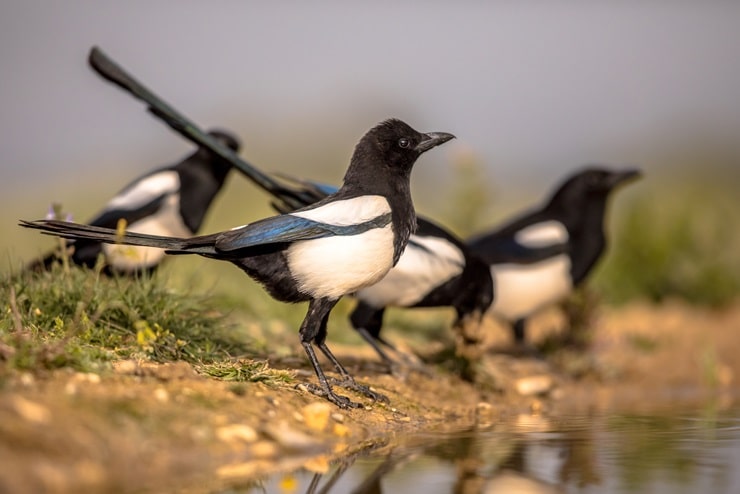
Magpies are social birds and flock together except during breeding season. Their colonies are often large and noisy, and they can create quite a mess with their droppings. These large flocks of magpies can cause a nuisance for humans, driving negative interactions between humans and magpies.
These intelligent birds flock together in complex social groups and share resources. Studies indicate that individuals that have food within a flock will notice when others do not have food and can be persuaded to share. These hungry individuals will beg other birds in the flock to share food.
Magpies also demonstrate another unique social behavior. When a magpie dies, other magpies will have a ceremonial gathering around the bird’s body for a short time before flying away without disturbing the corpse. Large numbers of birds have often been observed at these gatherings.
The negative superstitions surrounding magpies may be related to the amount of damage they can do when they congregate in flocks.
A group of magpies is most commonly called a mischief. This collective noun definitely relates to the amount of havoc they can wreak.
Additional collective nouns of magpies include:
- Tribe
- Parliament
- Murder
- Charm
- Congregation
- Conventicle
- Flock
- Gulp
- Band
- Flock
- Tittering
- Tiding
Magpies in North America were once hunted aggressively because people thought they were harmful to livestock and game species. Fantastical accounts of flocks of magpies devouring newborn fawns and fully-grown cattle fueled hatred for these birds, and states paid bounties for dead magpies.
In reality, magpies are omnivorous and feed on a wide variety of things. They eat grain, fruits, insects, small mammals such as voles, carrion, and the maggots found in carrion. They will even forage for food in other birds’ nests.
Eventually, the Migratory Bird Treaty Act added magpies to their list of protected species in 1972, ending the bounty programs. Today, these birds are suffering from population declines across their range most likely because of ingesting pesticides used by cattle ranchers and the spread of West Nile Virus.
What is a Group of Baby Magpies Called?
Magpies are highly adaptable, opportunistic nesters and will build nests in trees, shrubs, utility poles, suburban areas, and fields. Their nests can be large, sometimes 30 inches high and 20 inches wide (76 centimeters by 50 centimeters).
During the breeding season, magpies separate from the flock with their mate. Magpies are monogamous and stay with the same bird for life. These birds are territorial and where they nest, they will aggressively defend the area around them.
They can hatch up to nine eggs in their nest, once per year.
Baby magpies are called chicks and stay in the nest for up to a month before fledging and leaving the nest. Once the adults raise their brood, they return to their flock.
Do Magpies Migrate?
Magpies typically do not migrate during the winter. These birds maintain their residence in approximately the same place year-round, as long as they have sufficient food resources. They are not afraid of humans or other animals and will actively compete with animals for food.
These birds have been known to land on a coyote kill to grab a bite of food, or land on the back of a cow or moose and pick off ticks. Magpies have some cognitive reasoning ability that allows them to problem solve. As a result, they can often find food that may be hidden from other animals.
Despite the protections for magpies, their human interactions can still lead to death. If magpies are stealing food out of a pet’s food dish or ripping open trash bags left on the side of the road, homeowners will occasionally shoot these nuisance birds.
Few animal species on Earth can recognize themselves in the mirror. Mirror self-recognition is a sign of high intelligence. Besides humans, only apes, dolphins, and elephants have that ability.
Some studies have shown that magpies are also capable of recognizing themselves in a mirror. These birds are the first non-mammalian species to demonstrate that particular cognitive ability. This suggests that magpies are truly one of the most intelligent species on the planet.
Facts about Magpies
Magpies are intelligent birds found in the family Corvidae, along with jays and crows. There are four genera of magpies within the family. Eighteen species within these genera are distributed across North America, Europe, and Asia. Interestingly, the Australian magpies found on the Australian continent are not related to magpies.
These songbirds are known for scavenging shiny objects and taking them back to their nests. People who hoard items are often referred to as magpies in honor of this bird’s habits. Magpies prefer hanging out in open woodlands, meadows, and grasslands, but will stay near humans because of the ready sources of food available to them.
European cultures have incorporated magpies into many of their superstitions, mythologies, and lore. Over the centuries, magpies have become associated with thieves, bad luck, witchcraft, ill fortune, and death. This cultural association even followed magpies across the ocean into North America where they were once aggressively exterminated.
